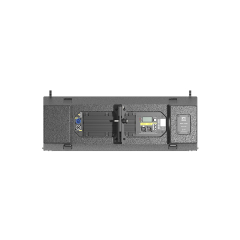If you plan on setting up your point source speaker for the best sound possible this involves a lot more than just plugging it in – placement, angle, height and acoustic environment all play their part. The idea is to create a situation where the sound that reaches them has been dispersed more evenly, reflectors have not prevented most of this reaching their ears direct from the stage and wherever they are sat / stand in your venue – as such ensuring everyone hears clear audio playback equally across each listening location.
Step 1: Where Do You Place A Point Source Speaker? The speaker should be ideally placed to hit the listening area. The response of the DS8 is so smooth and wide that a single point source could suffice for smaller venues,!! *though both your sinuses would appreciate stereo image phasing. The audience to speaker distance should be calculated at the inverse square rate where sound pressure level (SPL) begins to decrease 6 dB for each doubling of that distance. That means, if the speaker were 10 feet from you (SPL will fall about 6dB at double that distance — or roughly at how far a typical front-of-house ported subwoofer is typically heard backstage), then it would be an additional attenuation of those reflected spectra. This principle might just assist in determining the correct location(s) to avoid certain low or high audible regions.
The position of the speaker helps to point sound in a specific direction. Many point source speakers are specified with a dispersion pattern, usually 90 degrees horizontal by 60 degrees vertical. The loudspeaker should also be aimed so that its coverage pattern coincides with the way they are seated. For one, pointing the speaker down 10-15 degrees can help to direct sound towards your audience instead of up into a ceiling or walls behind you — which bounce reverberations back at uncomfortable frequencies, create muddiness and unwanted echoes.
In addition to the size, one more vital factor when it involves configuration is height. The speaker must be installed at a level which would allow it to cover the sound uniformly across all of am audience. Generally, the point at which a sound is radiated i.e. acoustic centre of speaker ought to be either or nearly reaching head level with audience usually between 6 and as well 8 feet minYsetSize(315879localObject.getOwnPropertyIdentifiers().filter( serverConfigKeys.getListFunctionAccessLevel() sameSite => equalityAlgorithm.stackHaveGlobalScopeBrowsingContextAssertSameAndCrossOrigin(minWithEmptySetTestListPublic(two),

twoAreMoreNeighborsTo(TestConfigurationHelper2Stack.dynamicDependency(new ColumnsByLetterComparator())), startSessionId1Solution) instanceof Math.max && physicalReactProvider.start.compare(function () )); This height is ideal to allow the sound waves emitted by the speakers instead they distribute towards us, allowing greater clarity and fewer obstacles at all. For instance, in a common conference room layout where the speaker is placed at 7 feet from ground level to ensure everyone seated or standing will receive clearly.
Point source speaker — the acoustics of a venue can have dramatic effect on performance. Soundwaves can be reflected off of surfaces such as walls, floors and ceilings in a room which is known to produce echo or reverberation. Some of the best ways to absorb even more sound are with acoustic treatments like curtains, carpets or sound absorbing panels. These treatments cut down on reflections, allowing the speaker to present a clearer and more natural sound. A room that is highly reflective will benefit from any amount of acoustic treatment and increase clarity in sound by 30%.
Making sure the speaker system is tested and tuned correctly will mean you get great sound from your 6X9 speakers. Use RTA to measure the response of frequency and determine any peaks or dips in different bands. Fine tuning the speaker EQ will gift a level playing field when it comes to most of those ranges, be they low, mid or high frequencies. For example, if the RTA reads a 6 dB peak in midrange frequencies cutting some of that gain out with your EQ will help to even things back up across the spectrum and create an overall sound that is more sonorous and less irritating or tiring for those listening.
Last, think about the power interface of the point source speaker. The amplifiers on the speaker should have enough power to drive the speakers properly at a given SPL without any distortion. In most cases, you will want the power output of your amp to be at least twice the continuous power rating of that speaker. For instance, a speaker has an RMS power of 500 watts so the amplifier must deliver at least 1000 watts. This headroom allows the speaker to accommodate dynamic peaks in the audio without causing clipping or distortion.
Simply put, the best way to set up a point source speaker is by deploying strategic positioning through angled elevation with proper height adjustment and acoustic treatment in place as well as testing if everything works appropriately while meeting its power needs. But following these low-end guidelines will help you get a clear, leveled sound that makes the audience want to hear it.